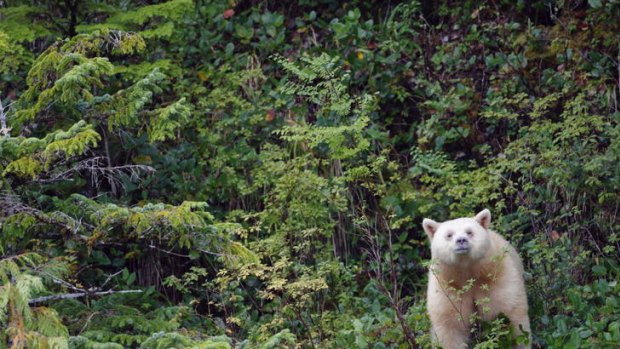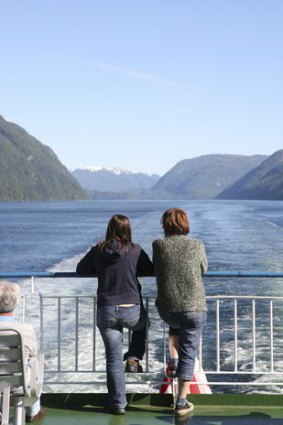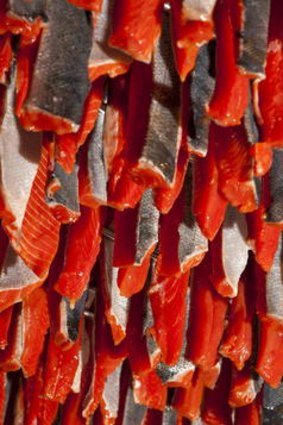
White magic ... a spirit bear in the wild.Credit: Getty Images
In the remote wilderness of British Columbia, Guy Wilkinson goes in search of the elusive spirit bear.
SCRAMBLING up a muddy riverbank, biologist Matthias Breiter has spotted something ahead. In the mud, fresh bear and wolf prints lead towards a creek littered with half-eaten salmon. On a nearby tree, claw marks are etched into the weathered bark. One thing's for certain: a bear can't be far.
Ahead of me Bernie Yau, an amiable middle-aged dentist, is feeling nervous.

Cruising the fiords.Credit: Getty Images
"Have you ever seen the movie, Grizzly?" he whispers.
Oddly I have but, as my mind conjures a collage of B-movie scenes involving a homicidal bear, I'm wishing I hadn't. Frantically, I struggle to recall the survival tips Breiter imparted earlier.
"If confronted by a bear, always stand your ground," he said. "If the bear is slightly aggressive or curious, try to be a bit aggressive back. Whatever happens, don't run or shout or you may force it into a more extreme reaction."

Catch of the day.Credit: Getty Images
I'm still suppressing visions of being mauled when Breiter spots movement in the long grass.
I notice the ears first, furry brown half-crescents peaking up through the bush. Not more than 50 metres away, an adult female grizzly is playing with her two cubs. Beside me, Yau has stopped breathing.
Briefly, the bear rears up, nose twitching. With a sense of smell 100,000 times stronger than a human's, there's no doubt it knows we're here. My heart thumps. It's exhilarating and I can't tear my eyes from the scene. Despite being so close, we always have the sense that this encounter is on the bear's terms.
Breiter is part of a four-man crew leading us on a sailing adventure through the remote fiords of British Columbia, aboard the 70-foot yacht Island Roamer. Led by skipper Neil Shearer, we're headed north along a labyrinth of narrow waterways between Vancouver Island and the Alaskan border. Once called the Mid Coast Timber Supply Area, this 64,000-square-kilometre stretch was renamed the Great Bear Rainforest by environmentalists in the 1990s.
Onboard is an eclectic mix. Some are wildlife enthusiasts toting camera lenses the size of small telescopes. Others are retirees or well-heeled hippies looking for a different kind of adventure. All of them share one desire: to see a Kermode bear.
Known as the "spirit bear" among the indigenous First Nations people, this creature is a walking anomaly. Thanks to a recessive gene, about one in 40 black bears is born with a pure white coat. On nearby Princess Royal Island, the odds are as high as one in 10.
If nights here are for kicking back, the days are all about adventure. From the deck, we watch humpback whales dive for fish. Spraying water from their blowholes, they dip beneath low vapour trails of mist, their colossal tails smashing the surface of the water.
By dinghy, we make frequent shore excursions and trek through lush, thick forests. Anything can happen here: it's a place where wolves and bears prowl coastal inlets filled with spawning salmon; waterfalls cascade from snow-dusted granite rock faces; and the smell of spruce, cedar and hemlock hangs heavy in the air like a persistent, earthy cologne.
Clearly, Shearer and his crew like to improvise. Rather than stick to a militant itinerary, they allow the day's events to unfold according to conditions.
It's for this reason we find ourselves headed directly beneath a waterfall, affectionately nicknamed Neil Falls. As the bow drifts beneath the spray of thousands of cubic tonnes of water, everyone rushes on deck to enjoy being drenched.
Scrambling to the bow, Yau fills a pitcher with some of the purest water on the planet. In the dinghy, first mate Brian Rainbow speeds a small group of us right beneath the powerful torrent. It's cold enough to steal your breath away.
Filled with bravado we take turns, one after another back-flipping off the edge into icy water.
Aside from the adventure, there's an educational component to the trip. The ship's library is stuffed with books on local wildlife and First Nations history. Breiter regularly holds talks below deck and there are opportunities to meet the people who live here.
At Hartley Bay, an isolated fishing village with a population of just 200, we're met by Daniel Danes of the Gitga'at First Nations Band. The toughest-looking guy ever to wear glasses, Danes manages the local salmon hatchery and gives us a tour of the village longhouse, the venue for town birthday celebrations and meetings.
In the centre of the room, a pile of rocks marks the gathering point for "stone feasts" – a northern hemisphere version of the Australian barbie. On the far wall, an elaborate mural depicts creatures integral to First Nations culture. At its centre is the spirit bear.
Danes also speaks of some of the challenges facing the coast. During the 1990s, this area was the stage for fierce debates between environmentalists and the timber industries.
A landmark agreement was reached in 2006 to ensure the protection of 2.1 million hectares from logging and although there is still conflict, a newer issue has emerged.
In the mid-2000s, the Canadian company Enbridge Inc announced plans to construct two oil pipelines from Bruderhein, Alberta, to Kitimat, British Columbia. If approved, the Northern Gateway Project would result in a steady stream of tankers lugging millions of barrels of unrefined crude oil through the narrow fiords to and from Asia.
Five years ago, the passenger ferry Queen of the North ruptured its hull and sank in these waters. That an oil tanker could do the same is unthinkable.
Just east of Hartley Bay is Gribbell Island. At a ramshackle wooden viewing platform facing a creek, we meet Marven Robinson of Gitga'at Spirit Tours.
Robinson has been coming to this island for 19 years and now guides eco-tourists to bear hot spots in the region. It's a far cry from the days when the town elders frowned upon even mentioning the spirit bear.
"Before I saw my first one, I was forbidden from even talking about it," he says. "That's how sacred it was; we didn't want too many people to know, as we were worried about trophy hunters."
Today, the hunting of spirit bears as trophies is illegal but shooting black bears that carry the recessive gene is not. Conservationists have set about buying vast chunks of hunting territory to prevent the killing and continue to lobby for an outright ban. On the river, Robinson has spotted movement.
An adult black bear and its two cubs are making their way downstream in search of food.
When the mother catches a fish, the cubs wrestle it from the parental grasp, learning early that fighting for food is essential to survival.
Then we see it. From the bushes a vaguely dishevelled white figure emerges. Pausing to sniff the air, a fully grown male spirit bear surveys the scene and is practically close enough to touch. Lumbering onto a small rock, it scoops a salmon fresh from the river, trapping it firmly beneath a giant paw.
From downriver, the black bear has noticed the spirit bear's arrival. With a whimper, the cubs scamper up a nearby tree. Crouched low, their mother strides towards the spirit bear, feelings clear; it is not welcome here. As the black bear bolts forward, the spirit bear is forced into a quick decision – fight or flee. Choosing the latter, it sprints up a fallen tree, the black bear in hot pursuit. Together they vanish into the forest. For a moment, no one says a word, not even Robinson. It's not a scene we will forget in a hurry.
Back on board, I reflect on our experiences. While the spirit bear encounter was a standout, our time here has been about so much more.
"People often take a while to 'arrive' here mentally," Shearer explains. "We come from a world that for many is filled with expectations on us but out here, you don't have to see a spirit bear, you don't have to complete a checklist. It's just a stunning place to be."
He has a point. Beyond the visuals, the trip has also illustrated the complexities of balancing conservation with an energy-hungry world. There has been an environmental theme throughout but we never feel hit over the head with it.
On our final night, gale-force winds have been forecast. Outside, it's raining hard. Though most of these waters are protected, we'll have to make a short hop in open seas to reach home. Shearer is unperturbed. Pumping his favourite song by Melbourne band the Cat Empire, he dances behind the wheel as some of the passengers also begin to jive around the cockpit. On deck, Rainbow readies the vessel.
High on the stern, the Canadian flag whips violently in the escalating breeze. It's blowing 28 knots. Standing beside Shearer at the wheel, I notice humpback whales feeding off the starboard side. A wall of salty spray hits the windscreen.
Turning to me with a smile, Shearer cranks the throttle, lurching us forward into the rising swell. Out here, you learn to take life as it comes.
The writer was a guest of Bluewater Adventures, Air Canada and Tourism Canada.
Trip notes
Getting there
Air Canada flies from Sydney to Vancouver from $1871, 1300 655 767, aircanada.com. Flights connect out of Vancouver International Airport and depart daily to the start and finish points of Bluewater itineraries. Pacific Coastal Airlines (pacific coastal.com) flies from Vancouver to Bella Bella. Both Air Canada and Hawkair (hawkair.ca) offer flights between Prince Rupert and Vancouver.
Cruising there
Bluewater Adventures offers a wide range of small-group, multi-day adventure excursions along the coasts of British Columbia and south-east Alaska. Great Bear Rainforest trips start from $C4400 ($4180) a person. All park permits and guiding fees, meals and a modest amount of wine are included in the price. Bluewater Adventures' voyages are ideal for those looking to get off the beaten track and explore remote wilderness while learning more about native wildlife and sustainable tourism. Tours run from May through to October, . +11 6049 803 800, bluewateradventures.ca.
Staying there
Bella Bella Shearwater Resort (+11 6042 706 204, shearwater.ca) and Whiskey Cove Bed and Breakfast (+11 2509 574 234, whiskeycove bedand breakfast.com) are located on Denny Island — a short water taxi ride away from the Bella Bella Municipal Dock. Rooms are from $90.
Prince Rupert Eagle Bluff Bed and Breakfast has rooms with private bath from $C110, +11 2506 274 955, eaglebluff.ca. The Crest Hotel has standard king rooms from $C139, +11 2506 246 771, cresthotel.bc.ca.
More information
Sign up for the Traveller Deals newsletter
Get exclusive travel deals delivered straight to your inbox. Sign up now.